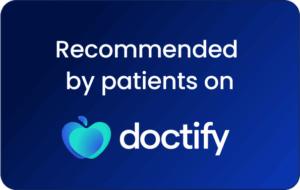The concept of prostate cancer recurrence after prostatectomy puzzles many patients. A frequently asked question is ‘how can the cancer come back if the prostate has been removed?’ The explanation is that, as with any cancer, if cancerous cells migrate out of the organ in which they arose before the organ is removed (or treated with radiotherapy), they can settle and grow elsewhere. These migrating cells are called metastases, secondary deposits or secondaries.
What factors increase the chance of cancer recurrence?
The likelihood of metastasis occurring increases with higher grade (aggressiveness) and stage (extent) of the cancer – as the more aggressive and developed the cancer is, the higher the chance of it breaking out of the prostate. More specifically:
- High Gleason grades (8-10);
- High clinical stages (T3-4);
- Positive surgical margins (where the tumour goes up to the edge of the prostate gland).
However, most prostate cancers are cured with surgery. As an example, using my results from operations performed on over 2,300 men with a variety of stages and grades, 96.3% of operations resulted in full cancer cure. Some combinations of minor prostate cancer (e.g. Gleason 6 and Stage 2a) had a 100% cancer cure rate, but the higher you go, the lower the full cancer cure rate.
The commonest sites of recurrence of prostate cancer following surgery are:
- the prostate bed (where the prostate used to be) – 80% of recurrence cases;
- lymph nodes – 15% of cases;
- bones – 5% of cases.
How soon can we detect this?
One of the main advantages of surgery over radiotherapy for prostate cancer is that following prostate removal, the PSA should be very low (less than 0.1 ng/ml), which we can of course detect with blood tests. If metastasis occurs, because the metastatic cells originated in the prostate and therefore make PSA, the PSA level in the blood starts to rise. Once it has reached a given threshold (0.1 – 0.2 ng/ml, depending on your urologist) additional or ‘salvage’ treatment will be discussed.
A PSA level of more than 0.2 ng/ml defines ‘biochemical’ (blood test) recurrence. At this stage the cancer is still much too small to be seen on scanning. If it can be seen on a scan it is termed ‘clinical’ recurrence, which generally does not occur until the PSA level is more than 0.5 ng/ml. Symptoms, such as bone pain, don’t usually occur until the PSA is more than 20 ng/ml.
Additional treatment after surgery
Additional treatment can come with one of two approaches: treatment given as ‘adjuvant’ therapy (given 3 months after surgery to maximise its effectiveness), or as ‘salvage’ therapy (given only if the PSA rises). In the modern era, most additional treatment is given as salvage therapy because firstly this spares unnecessary treatment for men who would never experience recurrence, and secondly because the success rates of the two approaches appear to be the same.
Regardless of whether an adjuvant or salvage therapy approach is taken, the main treatment options following biochemical recurrence are:
- Radiotherapy – this is the commonest approach. Because scans don’t show metastatic deposits until the PSA is more than 0.5 ng/ml and because radiotherapy is more effective when given before this level is reached, the radiotherapy energy is delivered to the prostate bed. This is because we know that this is the commonest site of recurrence in most men, and that 80% of men treated in this way will be cured.
- Active surveillance – this is appropriate for a very slowly-rising PSA in an elderly patient who has no symptoms.
- Hormonal therapy – in many ways this is the least appealing option as it causes symptoms but does not cure anyone, although it does control the recurrence and lower the PSA.
 Patient undergoing radiotherapy
Patient undergoing radiotherapy
Case study
JG was a 50 year old businessman who had a nerve-preserving radical prostatectomy done for a Gleason 3+4 (most of the cancer was 3/5 on the aggressiveness (Gleason) scale but he also had some 4/5 disease). His prostate cancer was of stage T1c, he had a normal rectal examination and a PSA of 9.8.
His final pathology report (once the prostate was removed and tested) upgraded his cancer to Gleason 4+3 (most of the cancer was 4/5 on the aggressiveness scale, with only the minority being 3/5) and upgraded his cancer’s stage to T3b (locally advanced). His lymph nodes were all clear. He was continent (no pads) and potent (could manage penetrative intercourse) by 3 months after surgery.
His PSA was undetectable up to 12 months after surgery, but rose to 0.1 ng/ml at 18 months and 0.2 ng/ml at 2 years. He had salvage radiotherapy over a 6 week period and had an unrecordable PSA thereafter. At 5 years following his radiotherapy he was discharged back to his GP for an annual PSA check. He remained continent and potent throughout.

